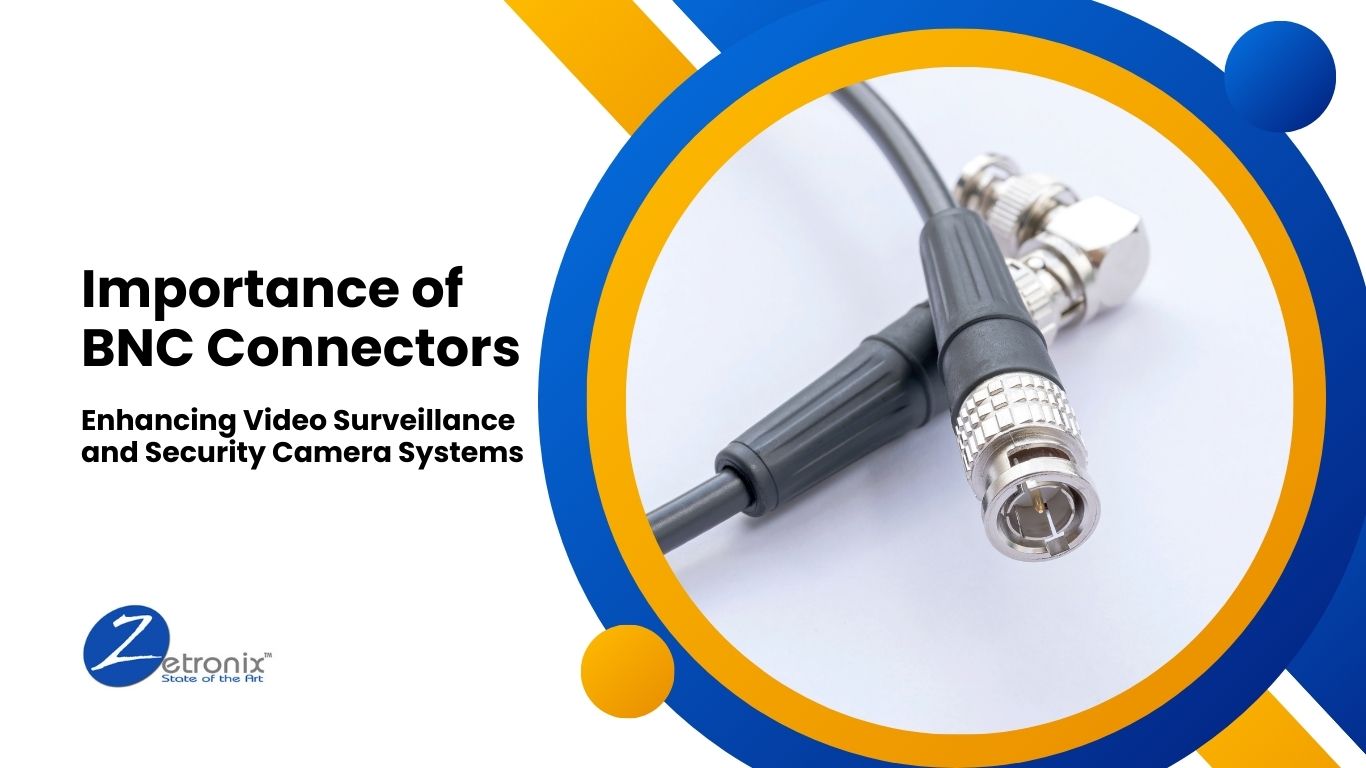Understanding the Role of a BNC Connector in Video Surveillance and Security Cameras

The BNC connector, an acronym for Bayonet Neill-Concelman connector, is a crucial component in video surveillance and security cameras. It is meticulously designed for transmitting video signals over BNC cables, ensuring not just connectivity, but reliable connectivity, and high-quality video transmission.
What is a BNC Connector?
A BNC connector is a type of coaxial cable connector renowned for its robust design and secure connection. It features a two-stud bayonet coupling mechanism, often referred to as a B and C connector, which allows for quick and easy installation without the need for additional tools. This user-friendly feature makes BNC connectors ideal for use in video surveillance applications where rapid deployment and reliable connections are essential.
The Role of BNC Connector in Video Surveillance
In the realm of video surveillance, where surveillance cameras play a pivotal role in monitoring and securing properties, the reliability of video transmission is paramount. BNC connectors facilitate the seamless connection between security surveillance cameras and monitoring systems, ensuring clear and uninterrupted video feeds.
Whether it's hidden surveillance cameras for discreet monitoring orsolar-powered surveillance cameras for remote locations, BNC connectors provide a dependable interface for transmitting video signals over long distances. Their durability and resistance to interference make them suitable for both indoor and outdoor surveillance applications.
Choosing the Right BNC Camera Cable
When selecting a BNC camera cable for your surveillance system, consider factors such as cable length, signal quality, and environmental conditions. Opting for high-quality cables with proper shielding can minimize signal loss and interference, resulting in clearer video footage and enhanced security.
Understanding the Role of a BNC Connector in Video Surveillance and Security Cameras
In the realm of video surveillance and security cameras, the BNC connector plays a pivotal role in ensuring seamless and reliable connectivity. This connector, known for its robust design and secure connection, facilitates the transmission of video signals over BNC cables with efficiency and precision.
BNC Connector is referred as-
A BNC connector, also referred to as a Bayonet Neill-Concelman connector, features a two-stud bayonet coupling mechanism, commonly known as a B and C connector. This design allows for quick and tool-free installation, making it ideal for use in video surveillance systems where rapid deployment is crucial.
BNC Connector in maintaining reliable connections:-
In the world of video surveillance, where surveillance cameras are deployed to monitor and secure various environments, the role of BNC connectors in ensuring uninterrupted video feeds cannot be overstated. They serve as the crucial interface between security surveillance cameras and monitoring equipment, contributing significantly to the effectiveness of surveillance systems.
Whether hidden surveillance camerasare used for discreet monitoring or solar-powered surveillance cameras are deployed in remote locations, BNC connectors provide a dependable connection that withstands environmental challenges and ensures consistent video transmission.
Conclusion:
In summary, BNC connectors play a critical role in video surveillance and security camera systems by facilitating reliable connectivity and high-quality video transmission. Whether used in home video camera systems or outdoor surveillance guide, BNC connectors provide a robust solution for transmitting video signals, contributing to enhanced security and peace of mind for users.For top-quality BNC connectors and expert advice, visit Zetronix today.
FAQs
What is a BNC connector, and what is its role in video surveillance?
A BNC connector, or Bayonet Neill-Concelman connector, is a type of coaxial cable connector used in video surveillance systems to transmit video signals reliably. It serves as the interface between surveillance cameras and monitoring equipment, ensuring seamless connectivity and high-quality video transmission.
How does a BNC connector differ from other types of connectors used in video surveillance?
Unlike other connectors, such as RCA or HDMI connectors, BNC connectors are known for their robust design and secure connection. They feature a two-stud bayonet coupling mechanism, allowing for quick and tool-free installation, which is essential in surveillance applications requiring rapid deployment.
Can BNC connectors be used for both indoor and outdoor surveillance applications?
Yes, BNC connectors are suitable for both indoor and outdoor surveillance applications. They are designed to withstand environmental challenges, such as temperature fluctuations and moisture, making them ideal for use in various surveillance settings.
What factors should I consider when choosing BNC cables for video surveillance?
Consider factors such as cable length, signal quality, and environmental conditions. Opt for high-quality cables with proper shielding to minimize signal loss and interference, ensuring clear and reliable video transmission.
Are BNC connectors compatible with different types of surveillance cameras?
Yes, BNC connectors are compatible with various kinds of surveillance cameras, including analog and IP cameras. They provide a universal interface for transmitting video signals, allowing for seamless integration with different camera models and surveillance systems.
How do BNC connectors contribute to enhancing security in surveillance systems?
By ensuring reliable connectivity and high-quality video transmission, BNC connectors play a crucial role in improving security in surveillance systems. They enable continuous monitoring and recording of surveillance footage, providing valuable insights for security personnel and helping deter criminal activity.
Can I install BNC connectors and cables myself, or do I need professional assistance?
While installing BNC connectors and cables is relatively straightforward, it's essential to follow proper installation guidelines to ensure optimal performance. If you need clarification on installation procedures or encounter technical challenges, consider seeking professional assistance to avoid any potential issues.
Where can I find additional resources or support for setting up a video surveillance system with BNC connectors?
You can find additional resources and support for setting up a video surveillance system with BNC connectors through online tutorials, user manuals provided by surveillance equipment manufacturers, and consulting with professional installers or technicians specializing in surveillance systems.
What types of devices commonly use BNC connectors besides surveillance cameras?
BNC connectors are widely used in various electronic devices besides surveillance cameras, including oscilloscopes, signal generators, and audio/video equipment. They are preferred for their durability and reliability in transmitting high-frequency signals.
Are there different types of BNC connectors available for specific applications?
Yes, there are various types of BNC connectors designed for particular applications, such as standard BNC connectors, miniature BNC connectors (BNC-M), and high-definition BNC connectors (HD-BNC). Each type has unique features and specifications tailored to different requirements.
Can BNC connectors support high-definition (HD) video signals in modern surveillance systems?
Yes, modern BNC connectors, such as HD-BNC connectors, are capable of supporting high-definition (HD) video signals commonly used in advanced surveillance systems. These connectors offer enhanced performance and compatibility with HD video formats, ensuring superior image quality and clarity.
How do I troubleshoot common issues with BNC connectors in video surveillance systems?
Common problems with BNC connectors in video surveillance systems may include signal loss, image distortion, or poor connectivity. Troubleshooting steps may involve checking cable connections, inspecting for physical damage, testing signal integrity, and replacing faulty components if necessary.
Are there specific standards or guidelines for installing BNC connectors in video surveillance systems?
While there are no particular standards exclusively for installing BNC connectors in video surveillance systems, it's essential to follow industry best practices and manufacturer recommendations for proper installation. This includes ensuring secure connections, maintaining cable integrity, and minimizing signal interference.
Can BNC connectors be used with wireless surveillance systems, or are they primarily for wired setups?
BNC connectors are used mainly in wired surveillance systems where cables transmit video signals between cameras and monitoring equipment. However, there are wireless surveillance systems that utilize BNC connectors to connect antennas or receivers, allowing for flexible deployment options.
What are some common accessories or tools used with BNC connectors in video surveillance installations?
Common accessories or tools used with BNC connectors in video surveillance installations include BNC crimping tools, compression connectors, BNC couplers, coaxial cables, and cable testers. These tools facilitate proper installation, maintenance, and troubleshooting of surveillance systems.
How do BNC connectors compare to other types of connectors in terms of cost and performance?
BNC connectors are generally cost-effective and offer reliable performance, making them popular choices for video surveillance applications. While other connectors, such as HDMI or Ethernet connectors, may offer higher bandwidth or digital transmission capabilities, they may also be more expensive and complex to implement




